#late roman period
Photo

The world’s largest ancient mosaic was uncovered in Antakya, Turkey. It covers 9,000 square feet (836 m2) and was made in the late Roman period, 4th century AD
34 notes
·
View notes
Text

Mosaic with Erotes Fishing
The mosaic, once part of a floor decoration, was excavated in Antioch, a city in Ancient Anatolia, modern-day Syria. It dates back to the Late Roman period, 2nd or 3rd century CE.
Source: 🏺
9 notes
·
View notes
Text

~ Oval gem with bust of Io.
Culture: Greek or Roman
Period: Late Republican or Early Imperial Period
Date: 100 B.C.–A.D. 50
Medium: Glass
#ancient#ancient art#history#museum#archeology#ancient history#archaeology#greek#Roman#imperial Period#late republican period#glass#gem#bust of io#io#100 b.c#a.d. 50
1K notes
·
View notes
Text

A ROMAN MARBLE PORTRAIT BUST OF THE EMPEROR LUCIUS VERUS
ANTONINE PERIOD, LATE 2ND CENTURY A.D.
Lucius Aurelius Verus (15 December 130 – January/February 169) was Roman emperor from 161 until his death in 169, alongside his adoptive brother Marcus Aurelius. He was a member of the Nerva–Antonine dynasty. Verus' succession together with Marcus Aurelius marked the first time that the Roman Empire was ruled by more than one emperor simultaneously, an increasingly common occurrence in the later history of the Empire.
Born on 15 December 130, he was the eldest son of Lucius Aelius Caesar, first adopted son and heir to Hadrian. Raised and educated in Rome, he held several political offices prior to taking the throne. After his biological father's death in 138, he was adopted by Antoninus Pius, who was himself adopted by Hadrian. Hadrian died later that year, and Antoninus Pius succeeded to the throne. Antoninus Pius would rule the empire until 161, when he died, and was succeeded by Marcus Aurelius, who later raised his adoptive brother Verus to co-emperor.
As emperor, the majority of his reign was occupied by his direction of the war with Parthia which ended in Roman victory and some territorial gains. In the spring of 168 war broke out in the Danubian border when the Marcomanni invaded the Roman territory. This war would last until 180, but Verus did not see the end of it. In 168, as Verus and Marcus Aurelius returned to Rome from the field, Verus fell ill with symptoms attributed to food poisoning, dying after a few days (169). However, scholars believe that Verus may have been a victim of smallpox, as he died during a widespread epidemic known as the Antonine Plague.
Despite the minor differences between them, Marcus Aurelius grieved the loss of his adoptive brother. He accompanied the body to Rome, where he offered games to honour his memory. After the funeral, the senate declared Verus divine to be worshipped as Divus Verus.
#A ROMAN MARBLE PORTRAIT BUST OF THE EMPEROR LUCIUS VERUS#ANTONINE PERIOD#LATE 2ND CENTURY A.D.#marble#marble bust#ancient artifacts#archeology#archeolgst#history#history news#ancient history#ancient culture#ancient civilizations#ancient rome#roman history#roman empire#roman emperors#roman art
160 notes
·
View notes
Text

Golden Hour (+ lineart below cut)
I took a picture of the lines for once and did some basic crappy photo editing on my phone, so you could probably print this out and use it as a coloring page or something if you so wish lol. Do with it what you will.

#honkai star rail#dr ratio#veritas ratio#aventurine#aventurine hsr#cherallart#as you can see i forgor i wanted to draw his glasses til like. last second#i can’t believe it’s been like 2 whole months since I last did a whole like. watercolor illustration#part of that’s been bc I’ve been having a bit of a rough semester bc adhd med issues (which are resolved now)#but I really wanted to draw aventurine and ratio. my boys#i’ve been LOVING penacony so far so I needed to get something nice out#anyway I did this while my s/o and I alternated between reading a 500 pg long history book out lout to each other#it’s called ‘the inheritance of rome’ and kinda covers what happened after the collapse of the western roman empire#and tries to identify and explain all the cultural echoes and reverberations and transformations that rose from its ashes#throughout europe north africa and the middle east. anyway it’s super interesting and I highly recommend it#the late antique period is not something often covered/talked abt in public ed hist classes. at least not when I was goin through em#or the transitory period between it and the early medieval period at least#i still got 150 pages left and a final paper due on it in like 4 days but it’s only a 5 pg minimum and I’m a wordy bitch so#i think i can make it#anyway back to that I go
72 notes
·
View notes
Text

The Favorites of the Emperor Honorius, John William Waterhouse, 1883
#art#art history#John William Waterhouse#historical painting#ancient history#Ancient Rome#Roman Empire#Roman history#Late Roman Empire#late antiquity#Honorius#Emperor Honorius#genre painting#Pre-Raphaelite#Pre-Raphaelite Brotherhood#pre-raphaelism#British art#English art#19th century art#Victorian period#Victorian art#oil on canvas#Art Gallery of South Australia
373 notes
·
View notes
Text
okay you know what? I think it's time for me to take advantage of the release of the Percy Jackson series to talk a little about the relationship between the Greek and Roman gods, because I have a feeling that we're going to have a new generation of people who are convinced that the Romans "stole" the gods of the Greeks and... um, I feel the need to talk and analyze this thing with you. Because the matter is much more complicated than you think
Like SERIOUSLY, the pjo fandom and Greco-Roman mythology enthusiasts in general need this chat.
First of all it is important to understand how the Italic populations came into contact with Greek culture, and who the first Romans were.
Southern Italy (Sicily, Calabria, Campania and Puglia) was colonized by the Greeks since the 8th century BC.
Like any colonization, the local population had to adapt to the culture, religion and language of the colonizer (in Italy there are still two dialects coming from ancient Greek. Griko in Puglia, and Grecanico in Calabria). Every part of the territory considered Magna Graecia (Megàle Hellàs) presents archaeological finds relating to the Greek colonies, and with them also temples dedicated to the gods. (So much so that in Sicily, at the beginning of spring the Antesphorie (or antephorie) were celebrated in honor of Demeter and Persephone, for example).
The entire Etruscan pantheon was strongly influenced by the Greek one. The indigenous deities were joined by the Hellenic ones, creating a new religion.
But still: who were the Romans? The legend of the foundation of Rome refers to Romulus and Remus, but from an archaeological point of view the Romans were probably the result of a mixture of Latin, Sabine (plus Samnites and Sabelli*) and Etruscan peoples. The latter influenced the initial Roman Pantheon the most. Just think of the similarities between the Etruscan goddess Menrva/Menerva and the Roman goddess Minerva.
The same applies to Maris and Mars, who among other things share holidays in March (a month dedicated to them moreover).
Unfortunately there is not much information on the Sabine and Latin ethnic group, but it is known for certain that Etruscans had contact with Magna Graecia, and the Greeks in general, so their culture was never unknown to the Romans.
So what does this tell us? That the Italic populations knew the Greek Pantheon, because they had been colonized and/or influenced by the Greeks. The first Romans can't exactly steal something that's already part of their culture.
*Samnites, Sabelli and Sabines were part of the same ethnic group, and although all three groups can generally be called "Sabines", I preferred to specify. At the same time it is not known how involved the Picenes and Irpinians were initially with the birth of Rome, so I have not mentioned them.
#it was a very quick and not very in-depth post#but it's late and I just needed to vent about this#if you want to make a joke about the Romans stealing religion from the Greeks that's completely ok#I do it too!!#but I think it is important to understand what really happened in the early period of Roman history#the Romans didn't wake up one morning thinking “you know what I should really do? steal a random religion”#the historical context is much more complex than what one might commonly think#and I understand that in schools outside italy there is no interest in explaining the phenomena that led to the birth of the Roman religion#but in doing so in my opinion it creates a great confusion that could be avoided#did the Romans assimilate numerous religions throughout their history? absolutely#just look at what happened with the Egyptian and Mithras#it wasn't a question of cultural appropriation but more of “I pray to all the gods that exist so no one can get angry with me”#greek myth#greek mythology#roman myth#roman mythology#roman history#greek history#pjo#pjo series#please learn about the Etruscan gods because they are much cooler than the Greek and Roman versions
9 notes
·
View notes
Text

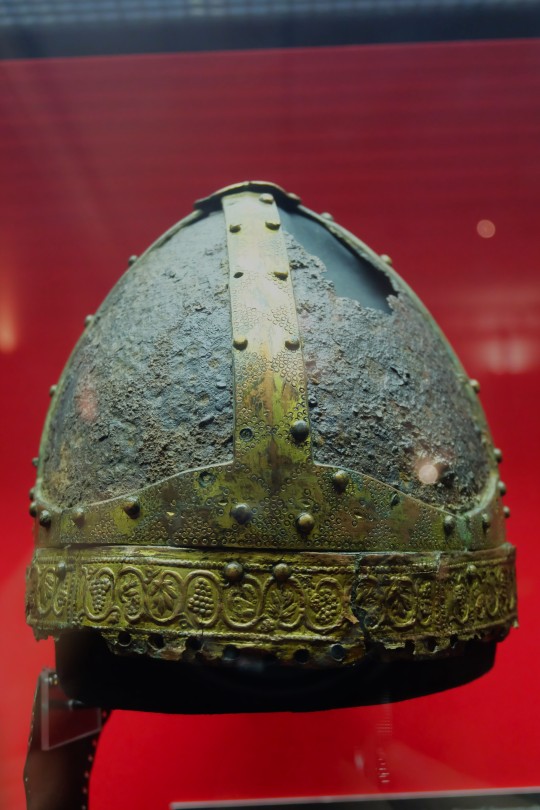
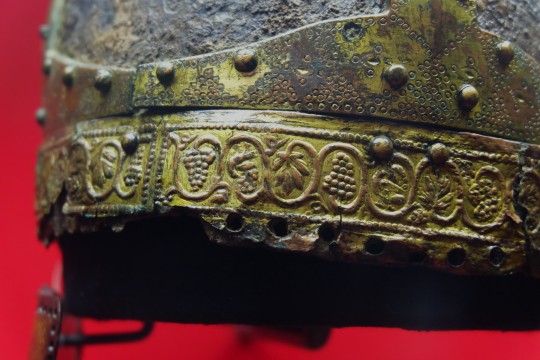
Spangenhelm Helmet thought to be from Istanbul, Turkey dated to around 500 CE on display at the Weltmuseum in Vienna, Austria
Spangenhelms, made up of an iron rim, clasp connections and individual plates, were primarily worn by Germanic high nobility and were sent from the Eastern Roman Empire as gifts to honour these nobles, primarily Frankish Princes. However these helmets can also be found in Vandal occupied North Africa, in the Balkans and Gotland, Sweden. The strangely complicated type of the helmet goes back to ancient Pontic and Iranian models and were brought to Europe by the migration of numerous Germanic tribes and trade with the Iranian nomadic peoples.
Photographs taken by myself 2022
#armour#archaeology#late antiquity#migration period#fashion#art#military history#easter roman empire#byzantine empire#turkey#turkish#6th century#weltmuseum#vienna#barbucomedie
8 notes
·
View notes
Text



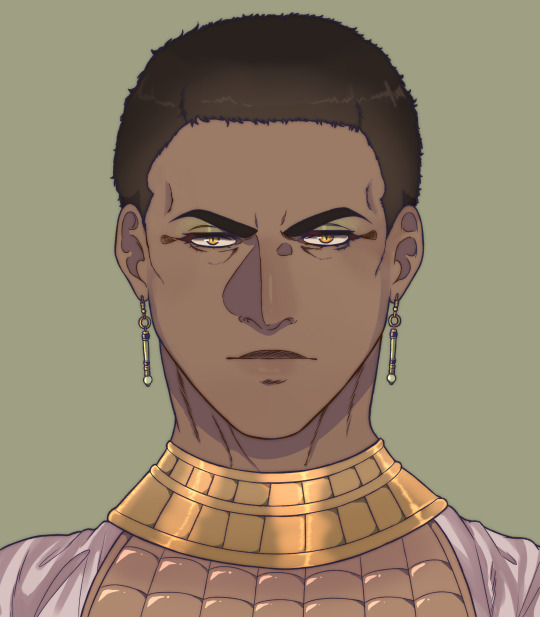

Introducing the main characters from the webcomic I'm developing on Ancient Egypt: Lucius, Djet, Iaret (Chloe), Khawy and Sempronia!
#webcomic#ancient history#pharaonic egypt#roman egypt#republican rome#imperial rome#ptolemaic egypt#new kingdom#late period#ancient egypt#ancient rome#vampires#my art#tfotds#the followers of the divine snake#smswart#thefollowersart#lucius#djet#iaret/chloe#khawy#sempronia
4 notes
·
View notes
Text
I’m currently reading about the proposals that circulated during the late 19th and early 20th century to unify Romania and Bulgaria under a single federation, and the main source for these that I found is Bulgarian.
#i have so much to learn…#it makes sense why i’ve never heard about this before#most romanian historians are strong proponents of the latin continuity theory#which claims that daco-romans continued to speak latin and live on the land of the former roman province dacia even after aurelian’s retrea#the idea of a bulgaro-romanian union in the late 19th and early 20th centuries#(a time period so crucial for the formation of the romanian state)#would have weakened the latin continuity theory#and strengthened the immigrationist theory which argues that daco-romans settled south of the danube after the roman retreat#which in turn would have de-legitimized romania’s claim for transylvania#thoughts are being thunk#bulgarian mutuals if you’re reading this i’d love to read your experience with this side of history#and how it was taught to you in school (if at all)#i can’t shake off the suspicion that the lack of romanian literature on this makes this one-sided…#my entries#romania#bulgaria
17 notes
·
View notes
Text
Last thought but like. The ptolemies....kinda sucked???? If we wanna romanticize a cool af Egyptian dynasty why do we have to Pick Them and insist that Cle*patra was a girlboss or whatever, when there are literally So Many Other ancient empresses and queens
#like theyre my fucked up lil guys. bc i love the awful hellenistic period#the same way i eat up the late roman republic of terrible bad politicians#but MODERN MORALS AND CONCEPTIONS OF RACE#DO NOT MAP ONTO THE ANCIENT WORLD#LITERALLY MODERN NOTIONS OF RACE ARE A COLONIAL INVENTION POST RENAISSANCE#GET OFF MY ASS#geez#everytime smthn classics goes mainstream i die a little inside#see also. tsoa#LET ME HAVE MY FUCKED UP LIL GUYS IN PEACE
17 notes
·
View notes
Text
what if i just fully unleashed my inner White Dad and started reading books about various civil war battles
#personal#been having A Week with all those 'oh men think so often about the roman empire whereas teehee girlies think about disney' takes#let girls think about the roman empire i think about it all the damn time#well really i think about the late republic/early empire/transitional period more because i like to read about augustus#but i was just reading about sherman's march to the sea and now i wanna read about civil war battles#either that or the romanovs but i can't find any really good books about the romanovs which is annoying#and NO ONE ever gave me good recommendations for books about the mughals except for that zebunissa book i'm reading rn#(also fun fact the civil war is when i'll be the most patriotic when it comes to america)#(cuz fuck the confederacy therefore full throated endorsement of the union and also fuck the confederacy and all confederates forever)
2 notes
·
View notes
Photo
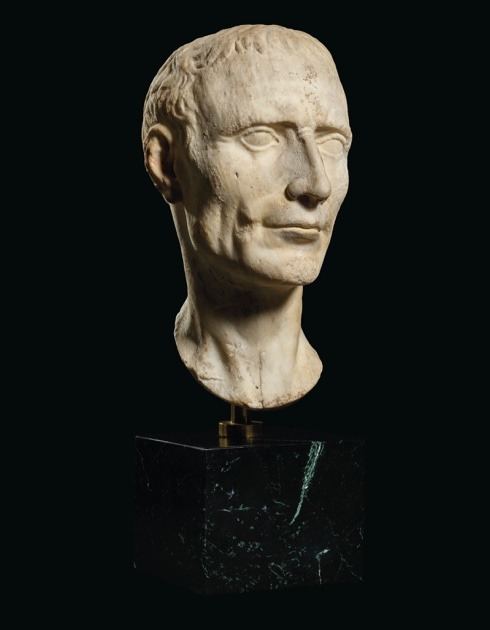
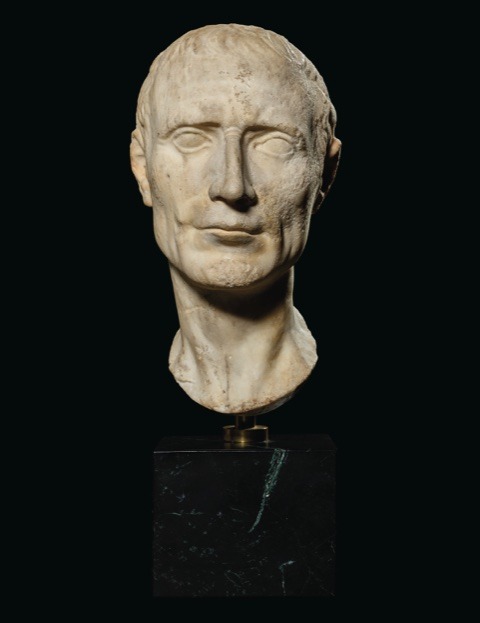

A ROMAN MARBLE PORTRAIT HEAD OF A MAN
REPUBLICAN PERIOD, CIRCA LATE 1ST CENTURY B.C.
11 7/16 in. (29 cm.) high
In a letter to the previous owner from 1991, Cornelius C. Vermeule wrote: "This Republican head does look like Julius Caesar, but is probably someone else of his era, like the head restored on the Barberini togatus of the man holding the busts of his two ancestors. There was also a great vogue for reviving Republican portraiture in the late First and early Second centuries A.D., and Republican lookalikes, such as Hadrian's brother-in-law L. Julius Ursus Servianus."
As Vermeule notes, this example's likeness to Julius Caesar is striking, particularly to a bust of the dictator known as the "Chiaramonti-Pisa Type," now in the Vatican Museum (see F.S. Johansen, "The Portraits of Marble of Gaius Julius Caesar: A Review," fig. 1a). As he goes on to explain however, it was common practice beginning in the Republican era to commission private likeness after prominent public figures and likely this is what we have here. In his extensive study, Johansen writes that he believes only two actual representations of Caesar himself exist in marble, the first being the aforementioned example, and the other being a bust thought to be commissioned in his lifetime, known as the "Tusculum type" (see figs. 1a and 15a, op. cit.). Nevertheless, the present example illustrates that while the veristic style was certainly in vogue with reference to Republican portraiture, it did not prohibit artists nor their patrons from using other people's likenesses as inspiration.
#A ROMAN MARBLE PORTRAIT HEAD OF A MAN#REPUBLICAN PERIOD CIRCA LATE 1ST CENTURY B.C.#marble#marble statue#marble bust#ancient artifacts#archeology#archeolgst#history#history news#ancient history#ancient culture#ancient civilizations#ancient rome#roman history#roman empire#roman art
29 notes
·
View notes
Text
Has anyone listened to Cry Havoc! Ask Questions Later, and if so, thoughts?
#my area of study in classics for my degree was the late roman republic/early empire so i'm a snob when it comes to media about that period#but i love a lot of the rusty quill produced podcasts and i'm VERY intrigued by the fact that it's a comedy#realistically i will listen to it but i haven't seen anyone talk about it so i thought i'd ask
3 notes
·
View notes
Text
I think we can criticise netflix's Cleopatra without falling into nazi dogwhistles
#or rather nazi loudspeakers at this point lmao#@everyone saying this is afrocentrism/blackwashing ur wrong lol#i think this is just another side of american centrism and to a certain extent chauvinism#the kind that likes to portray itself as progressive but excludes the narratives to whom this history really belongs to#like i havent seen the doc in full but from the bits ive seen i dont think they consultes egyptian or greek#historians archaeologists egyptologists etc#+ they have colleen darnell in there and while i dont think shes bad her area of expertise isnt ptolemaic egypt#i dont doubt she knows her share of things about that period but thats a bit like making a documentary about the modern period#and having a historian who is an expert on the late roman empire/early middle ages in the pannel#+ shes mostly known for being a bit of a fashion influencer who happens to be an egyptologist#over just being an egyptologist
2 notes
·
View notes
Text
"Men Complaining About Women's Fashion For 8 Minutes (And 500 Years) Straight"
youtube
#*literally any time period*#you can read late medieval men complaining about hennins and long gowns and ancient roman men complain about women dressing to expensively#etc.etc.#the 18th century one is hilarious lol#karolina zebrowska#fashion history#sexism#Youtube
5 notes
·
View notes